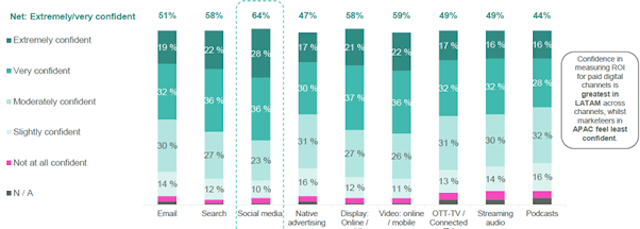A crisis of confidence: the race for full-funnel ROI measurement
Global marketers agree that full-funnel media ROI is an extremely/very important marketing metric – but they aren't confident in their ability to measure it. We explore the latest findings from Nielsen’s 2022 Global Annual Marketing Report to find out what's driving this crisis of confidence and what solutions are required to overcome the need for holistic measurement.

Marketers should be increasingly focused on strategies that provide holistic views of consumers
Consumer journeys aren’t isolated to specific platforms and channels, so why should measurement be? In an increasingly fragmented media landscape – where the customer journey doesn’t start at A and end at B, but can start at A and sometimes end at Z – marketers must look to un-silo their measurement and create holistic strategies that track across the full funnel.
According to Nielsen’s latest Global Annual Marketing Report, full-funnel media return on investment (ROI) is, predictably, considered an extremely/very important marketing metric for 61% of global marketers. However, while marketers are somewhat confident in their ability to measure ROI across social media (64%), online/mobile video (59%) search (58%) and display (58%), only 54% of global marketers are confident in their ability to measure full-funnel ROI.
“It’s a unique time for digital marketing with numerous factors likely contributing to this shaky confidence – deprecation of third-party cookies, increased legal constraints in Europe due to GDPR, measurement limitations in walled gardens, the elimination of mobile ad IDs (MAIDs) and Apple Intelligent Tracking Prevention (ITP), to name a few,” explains Emma Delserieys, vice-president, customer success Europe, marketing effectiveness, Nielsen.
“All of these factors combined are amplifying issues within media channels that have historically been difficult to measure (such as sponsorship or influencer) compared to the rest of their media mix,” she adds. “The onus is on tech vendors to not only solve for these issues but to provide assurance in measurement capabilities as brands work towards finding holistic solutions.”
Global confidence in measuring the ROI across paid channels

A mismatch of information
Nielsen data shows that more than half of marketers’ advertising budgets were spent on digital channels in 2021, and they plan to significantly increase budgets in the next year. But there’s a sense of lackluster confidence in being able to prove ROI, despite leaning into newer channels.
Globally, two-thirds (65%) of marketers believe new formats, like podcasts, brand integrations and sponsorships are greatly important to marketing strategies, but they’re not convinced that they have the tools to measure ROI of these investments. For example, almost half (49%) of the marketers surveyed plan to increase spending on podcasts – some 11% expecting to increase spending by more than 50% – but their confidence in measuring the ROI of that investment remains fairly low.
Despite this lack of confidence in tracking podcast ROI, marketers shouldn’t overlook this growing media channel, advises Nielsen – with the report stating that Nielsen’s Podcast Ad Effectiveness (PAE) solutions show that host-read ads drive a brand recall rate of 71%, which subsequently creates high levels of consumer interest, purchase intent and recommendation intent.
“The online experience that consumers today have is infinite – as they toggle between devices and platforms, it’s clear that attention is divided. But there’s always a time and place where they focus – and that’s where marketers must be, armed with the right message,” says Delserieys. “From a marketing perspective, using technology to engage, measure, optimize and prove ROI has never been more rampant, but marketers should be increasingly focused on strategies that provide holistic views of consumers – not just channel- or platform-specific look-ins.”
Optimizing the channel mix
Somewhat surprisingly, 73% of marketers globally are satisfied with their measurement tools – but looking in the EMEA region specifically, only 58% of marketers express satisfaction with the tools they have to measure their marketing activities. The disconnect between confidence in full-funnel ROI measurement in preferred channels and overall martech satisfaction presents an opportunity for partners to provide assurance in measurement capabilities where confidence is muted to help brands improve their execution and results.
“Marketers should work on understanding and quantifying the relationship between brand awareness and sales, with the right measurement solutions and partners, to ensure they do not leave opportunities on the table,” says Delserieys.
The problem is that individual industry solutions don’t typically account for both upper- and lower-funnel marketing efforts in the same solution. So, to address the need to balance short-term sales and to seed long-term growth, marketers should run effectiveness studies for both short- and long-term ROI.
One way to do this, Nielsen suggests, is to run marketing mix models (MMMs) to optimize channel mix for short term sales, and then use a second analysis to optimize channel mix for awareness or other upper-funnel metrics. Then, brands should look at both plans and weight them together based on the goals of the organization. That way, helping brands create a more balanced path that supports both their short-term needs and long-term ambitions.
Marketing budgets are no stranger to scrutiny, but the past two years shine an even brighter light on the importance of efficient and effective spending. To overcome this crisis of confidence in measurement, especially when it comes to next-gen channels, marketers should look to leverage technology that delivers on their needs and focus on solutions that give them the confidence they need to show that their investments are paying off.
“In this changing world with budgets under the microscope, marketers today must remain agile and adaptive,” advises Delserieys. “Having insight into the consumer is the best way to stay agile and adaptive. Investments in trusted and robust data sources will be money well spent in the race for full-funnel ROI measurement.”
For more insights on future-focused strategies for brand building and customer acquisition, download Nielsen’s Global Annual Marketing Report here.
Content created with:

Nielsen
Nielsen shapes the world’s media and content as a global leader in audience measurement, data and analytics. Through our understanding of people and their behaviors...
Find out more
